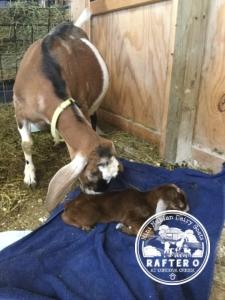
We did not have barn cameras for our first kidding season here at the Rafter O. As the due dates approached, we physically monitored the does every few hours. For our very first kidding with Kandi, she already had a kid on the ground when I went to check on her about an hour after the previous check.
After our first kidding season with several surprises and a high level of exhaustion, I began researching barn cameras. I purchased some wired cameras that I was going to hook up to a hard drive and connect all of this to WiFi which I would attempt to extend the coverage from the house. After many hours of trying to get all of this to work, nothing would function properly so I went back to the drawing board and began researching again.

Ideally, my new camera system would be able to be viewed from anywhere in the world. Several goat folks had recommended baby cameras with the monitor screen in the house. This would work okay, but I wanted to be able to view my cameras when I was away from home. The cameras must have night vision so I can view the goats in the dark. These were my basic requirements. I knew that there were game cameras that utilized LTE (wireless) data, and when researching those, I came across the newly released Arlo Go cameras that work off of LTE wireless connections.

The Arlo Go cameras met all of my needs perfectly, and had many extra perks! Arlo has an app for Apple and Android – so I have the app loaded on my phone and iPad. This app is easy to use! You can even allow others to view your cameras by sending them an invitation. My nephew, Carson, has been able to log on to the app and view many kiddings and watch the goats. When I am traveling for work, I can view my cameras from wherever I am located. My parents also enjoy checking on the cameras during kidding season as well. You can also view the cameras on the website.


The Arlo Go cameras can be placed anywhere! They are IP65 certified weather-resistant. We have two cameras at the Rafter O. During kidding season, we have the camera over the kidding pens. After kidding season, we place this camera in the doe pen so we get a wide view of the outside area. The other camera stays permanently in the “Gen Pop” area of the doe barn.
Other perks include HD Quality images and the ability to record videos and screenshots in high resolution even at night. The batteries are rechargeable and last a good while. I purchased two extra batteries and a battery charger. I switch out the batteries when they get low, and have the others charged and ready to go for next time. When I’m looking at the cameras a lot, the batteries last about 2-3 weeks. Other times of the year, I can go about 5-6 weeks before they need to be switched out.

The other awesome extra that these cameras have is the ability to change the mode to “Armed”. These cameras are designed to also function as a security device where you can have alerts set for motion and/or audio detection. If motion and/or audio is detected, you can then tell Arlo what to do: record a video, activate siren, push notification, or email alert. Obviously, you will want to adjust these settings for your goat barn. You don’t want to have the siren going off if motion is detected! I have my kidding pen camera set on a schedule to be Armed from 8:00 pm to 7:00 am. It will send me a Push Notification to my phone or iPad when it detects audio. You can even further adjust the sensitivity settings of the audio detection with 1 being less sensitive to 5 being the most sensitive. I have mine set to 2, and it really saved me this year for Doodlebug’s kidding.

When the does are close to kidding, I check on them every one to two hours. I had just checked on both her and Ruby on the camera and didn’t notice anything out of the ordinary. Then, about twenty minutes later, I hear the Push Notification on my iPad that audio is detected on Barn 2…I look at the camera and hear Doodlebug screaming in labor. We rushed out to the barn, just in time for her doeling, Pill Bug, being born. Doodlebug was a first freshener so she was a little unsure of what to do with her new baby. Thankfully, the camera alerted us, and we were able to help her get Pill Bug cleaned up and nursing.

Now you are wondering, how much do these cameras cost? How much per month? You’ll need to purchase your Arlo Go cameras according to your Wireless provider. AT&T, Verizon, US Cellular, and T-Mobile all currently offer data plans for the Arlo Go cameras. The cameras currently retail for $349.99 each. I have my two cameras on an AT&T data plan, and it costs me about $14/month/camera including taxes. I do recommend negotiating your rates with your provider and monitoring your data rates for unexpected rate hikes. I also purchased the rubber skins that provide a little extra protection from dust and the elements – they were about $10 each.
In summary, the Arlo Go cameras meet all of my needs and are a great fit for my farm. I highly recommend these cameras for those that cannot extend WiFi to their barns, or those looking for an easy plug and play solution. I also have an Arlo Q camera in my office where I can check on my house dogs in their kennels when I am away from home. Arlo has lots of other solutions that are worth looking into as well. Let me know if you have other questions!




